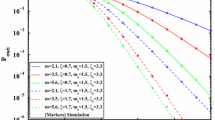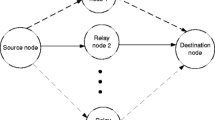Abstract
Dual hop wireless links offer a simple means of achieving broad coverage through low power transmitters. But, such systems are not immune from fading present in all wireless systems. While several fading models exist, fading treated as a cascading process, namely the cascaded model, allows flexibility in describing channel conditions that are far worse than those existing in Nakagami channels. In this work, an exact analysis of a dual hop link operating in a cascaded N*Nakagami channel is studied. The error rates were estimated using the exact model and compared to the results obtained using random number simulation. These results show an excellent match suggesting the strength of the approach. While the dual hop systems might offer simplicity, the error rate analysis in such systems illustrates that the performance is worse than what is seen in a conventional direct link.






Similar content being viewed by others
References
Tsiftsis, T. A. (2008). Performance of wireless multihop communications systems with cooperative diversity over fading channels. International Journal of Communication Systems, 21, 559–565.
Hasna, M. O., & Alouini, M. S. (2003). End-to-end performance of transmission systems with relays over Rayleigh-fading channels. IEEE Transactions on Wireless Communications, 2, 1126–1131.
Hasna, M. O., & Alouini, M. S. (2004). A performance study of dual-hop transmissions with fixed gain relays. IEEE Transactions on Wireless Communications, 3, 1963–1968.
Karagiannidis, G. K. (2006). Performance bounds of multihop wireless communications with blind relays over generalized fading channels. IEEE Transactions on Wireless Communications, 5, 498–503.
Bissias, N., Efthymogloua, G. P., & Aalo, V. A. (2012). Performance analysis of dual-hop relay systems with single relay selection in composite fading channels. International Journal of Electronics and Communicactions, 66, 39–44.
Cao, J., Yang, L.-L., & Zhong, Z. (2012). Performance analysis of multihop wireless links over generalized-K fading channels. IEEE Transactions on Vehicular Technology, 61, 1590–1598.
Ilhan, H., Altunbas, I., & Uysal, M. (2011). Moment generating function-based performance evaluation of amplify-and forward relaying in N*Nakagami fading channels. IET Communications, 5, 253–263.
Senaratne, D., & Tellambura, C. (2010). Unified exact performance analysis of two-hop amplify-and-forward relaying in Nakagami fading. IEEE Transactions on Vehicular Technology, 59, 1529–1534.
Karagiannidis, G. K., Sagias, N. C., & Mathiopoulos, P. T. (2007). N*Nakagami: a novel stochastic model for cascaded fading channels. IEEE Transactions on Communications, 55, 1453–1458.
Shankar, P. M. (2012). Fading and shadowing in wireless systems. New York, USA: Springer.
Gradshteyn, I. S., & Ryzhik, I. M. (2000). Table of integrals, series, and products (6th ed.). New York: Academic.
Papoulis, A., & Pillai, S. U. (2002). Probability, random variables and stochastic processes (4th ed.). New York: McGraw-Hill.
Author information
Authors and Affiliations
Corresponding author
Rights and permissions
About this article
Cite this article
Shankar, P.M. Error Rates in Dual Hop Wireless Links Operating in Cascaded Fading Channels. Wireless Pers Commun 75, 1–9 (2014). https://doi.org/10.1007/s11277-013-1336-0
Published:
Issue Date:
DOI: https://doi.org/10.1007/s11277-013-1336-0




